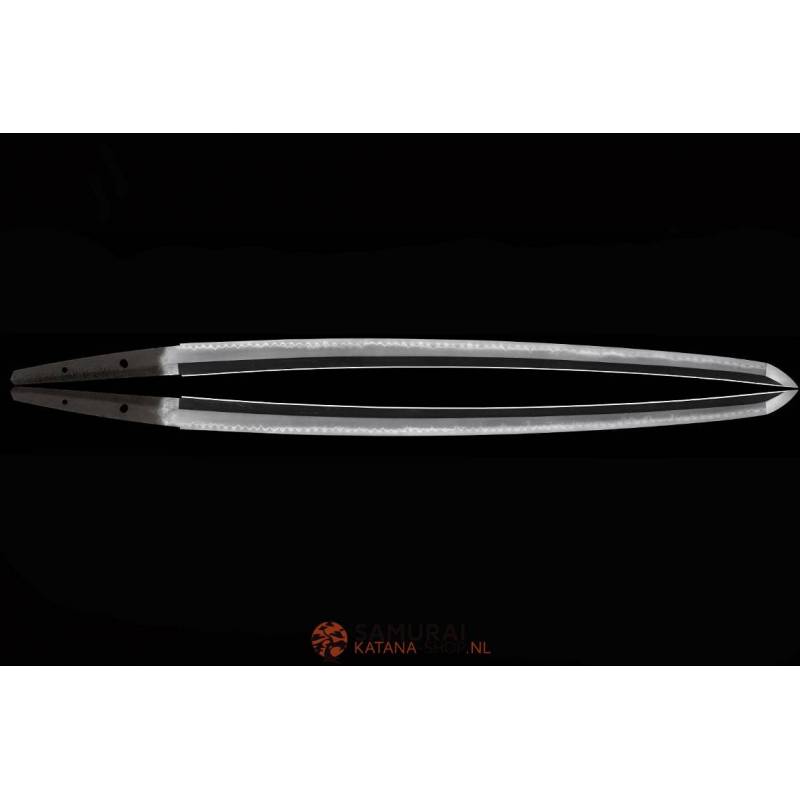














A unique antique Wakizashi Katana by Musashi Kami Fujiwara Kanenaka with NBTHK Hozon from the Tenna period (early Edo) with beautiful Koshirae and Ko-itame hada and bonsugi style hamon.
Sold!
A real authentic Japanese Wakizahsi from the Tenna period (1681 to 1684). This is early Edo and the reigning emperor was reigen-tennō. This wakizahsi comes from the Echizen province, which was very prosperous during the Edo period and power lay with the Matsudaira clan, a direct vassal of the Tokugawa clan. Many skilled swordsmiths from different regions moved to Echizen because of the many samurai living there. Many famous katana smiths came from Mino Province (Gifu Prefecture) and were called the Echizen Seki group.
This wakizahsi is signed Musashi Kami Fujiwara Kanenaka and it is believed that Kanenaka was a descendant of Magoroku Kanemoto, one of the most famous swordsmiths in Mino Province (present-day Gifu Prefecture). A very clear and powerful May or signature.
Given the honorable title of van Musashi no Kami, which at the time was only given to highly trained and experienced swordsmiths, we also assume this.
Of course forged in an authentic Japanese way of tamahagane with a ko-itame hada in excellent condition. Due to the relatively long blade, this is an o-wakizashi with a wide blade and long kissaki. The itama hada is very lively with many visible veins and beautiful surface. An ubu nakago or original pliers that have not been shortened and are therefore still in full condition as they were forged. The jigane or steel is of good quality with nice color and prominent hamon in sanbon sugi style (3 cedar trees). This style is a unique feature of the famous blacksmith Kanemoto's who forge many sword blades in the togari ba style. In this hamon you can also discover Kinsuji.
The Nakago is the tang of the Japanese sword and the swordsmiths have left the black rust on the tang so that it prevents red rust while the tang remains in the handle. You should never remove this rust because it is a good indicator for a Japanese sword specialist to estimate when the sword has been forged. The tongs are equipped with two mekugi-ana.
koshirae
This ray skin saya is unique and shows that they are true artists. This saya is is han-dachi and means half tachi and in this case half wakizashi. This was more common during transition from horseback fighting to the ground. The samurai first used the tachi on horseback and later the katana with ground fighting.
In the Saya we also find the Kogatana. An ornate engraved Kozuka (handle) of the small knife (Kogatana)
A round iron tsuba with an engraved tiger and bamboo. The fuchi in nanako with a family coat of arms or mon in shakudo. A nami or waves kashira in handachi style. The tsuka or handle is wrapped in Katate maki with a menuki with a gourd and tendrils in shakudo.
All in all a skilled wakizahsi who has rightly obtained his NBTHK papers.
Specifications:
Blade length: 54.4 cm
Sori: 1.2 cm o
Width at the hamachi: 2.95 cm
Width at the Kissaki: 1.01cm
Kasane: 0.72 cm
Weight: 520 grams.
And another once in a lifetime opportunity to buy an authentically crafted Japanese Samurai Sword. A unique and beautiful piece of history from Japan and what an honor to be able to sell this. This Nihonto deserves a place somewhere where it will be treated with honor and respect.
Apart from the fact that this is a great sword to display in your home, I can tell you with certainty that it is a good investment and will hold its value. The NBTHK has provided this sword with the necessary papers. This Wakizahsi or short sword comes with NBTHK Hozon Token papers.
You can read more about it here, if a katana gets a Hozon certificate, this is already exceptional
Including Oshigata. Oshigata is a drawing of the blade which records all the metallurgical activities of the blade so as to create a good picture of the unique katana.
This is an antique sword and is therefore subject to the test of time and this will be visible in some places.
Of course provided with NBTHK Hozon Token papers which guarantee the authenticity.
Never touch the katana with bare hands
Do not breathe in the direction of the blade
Do not rest the Katana on the kissaki
When indicating the katana do not point the point and the cut towards the indicated person
When throwing up the katana it is recommended to do this in the saya
.jpg)
.jpg)
.jpg)
.jpg)
.jpg)
.jpg)